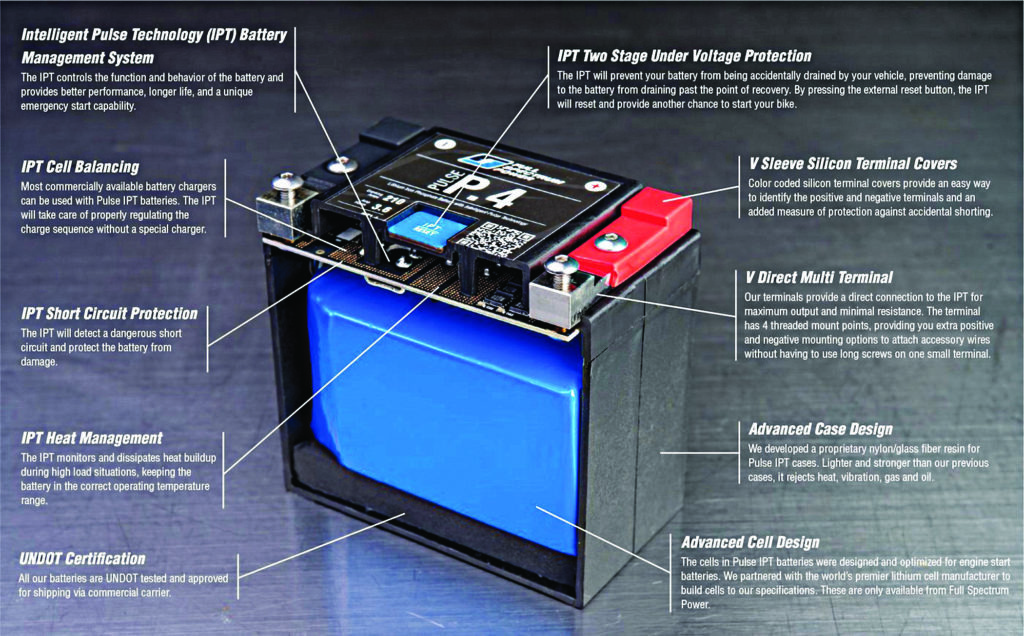Getting The Lead Out
So let’s be frank here. Big V-twins are battery-killers. Particularly those with monster motors and/or every bell and whistle known to man on board.
To nobody’s surprise, there is a better mouse trap. The improvements provided by lithium iron phosphate (LiFePO4) technology (call ’em LFP for short, or plain LI) offer real advantages over ye lead-acid of yore.
The primary benefits of LI – light weight, cranking power, durability and more – are well-known, but research is always the best way to arrive at an on-the-ground purchase decision. Reading the advertised numbers doesn’t always tell the complete story and negates most legit comparisons between Absorbed Glass Mat (AGM) tech and LI. It’s apples and oranges. More details can be had in a Google search or YouTube. Your local dealer can usually fill you in as well.
There’s no argument that LI does a better job. No grunt and groan from your bike’s starter motor – just excellent cranking power. Rest assured that if LI won’t start your bike better, it’s the bike’s fault, not the battery’s.
Then there’s the weight of LI batteries, or rather, the lack of it. A good thing always, but not a priority for the majority. Obviously, it’s a selling point for performance freaks and chopper builders, but for a typical bagger rider, a few pounds off the top might be more sideshow than main event.
For aspects other than starting, baggers (any V-twin) sporting a load of parasitic electric losses (aka accessories) shouldn’t have their batteries blamed. The stock charging system could be overwhelmed – and probably is – by too many accessories.
Next up is battery life, and on paper, at least, an LI’s is gonna be more than double that of an AGM battery, especially under average conditions. It’ll be better than that under conditions we’ll get to shortly, but worse if you are as much a battery killer as your V-Twin. Well-kept and properly fed, an LI battery versus an AGM is like LED lights compared to incandescent…a brighter, better idea, period.

Lithium batteries aren’t cheap. Still, I’ll wager that what you get from the deal is worth more than the expense involved, if for no other reason than the superior technology involved and the peace-of-mind that comes with it. In terms of a reliable-starts-per-dollar measurement, LI beats AGM hands down, and that makes LI cheaper to own in the long run.
Curiously, H-D doesn’t list fitment of LI batteries for bikes older than 2004. Basically, that means not much that isn’t fuel injected, and basically, nothing that doesn’t have a three-phase alternator. And here’s why: Three-phase alternator systems need more precise voltage regulation to avoid troubles with EFI and on-board electronics. Those regulators also kick in at lower rpm.

We know lithium batteries need very precise and stable charging rates. That’s why they require special smart chargers. Well, it stands to reason if they need that on the bench, they need that on the road. Single-phase charging systems fitted to almost all pre-EFI Harleys simply aren’t capable of keeping the right amount of DC fed back into the battery at low speeds. Even at higher speeds, (2500 rpm-plus) older systems have issues with overcharging or undercharging.
The problem here is the rectifier/regulator. Your old SCR R/R is very slow to switch, requiring lots of electrical current that results in a great deal of heat and variations in battery voltage. Matching a fresh LI battery to a new “metal oxide semiconductor field effect transistor” regulator/rectifier – Mosfet for short – can fix the problem. The Mosfet R/R is extremely quick to switch and requires much less current, resulting in a much cooler unit and significantly more stable battery voltage. That’ll do the trick for most of us with older bikes and simple demands.
Unless you’ve already exceeded the capabilities of the alternator itself, of course. It’s practically scripture that older baggers using LI will want to update the alternator, as well, for their typical extra demands. More powerful single-phase (and three-phase) upgrades are readily available. So get the lead (acid) out…and get started!


















